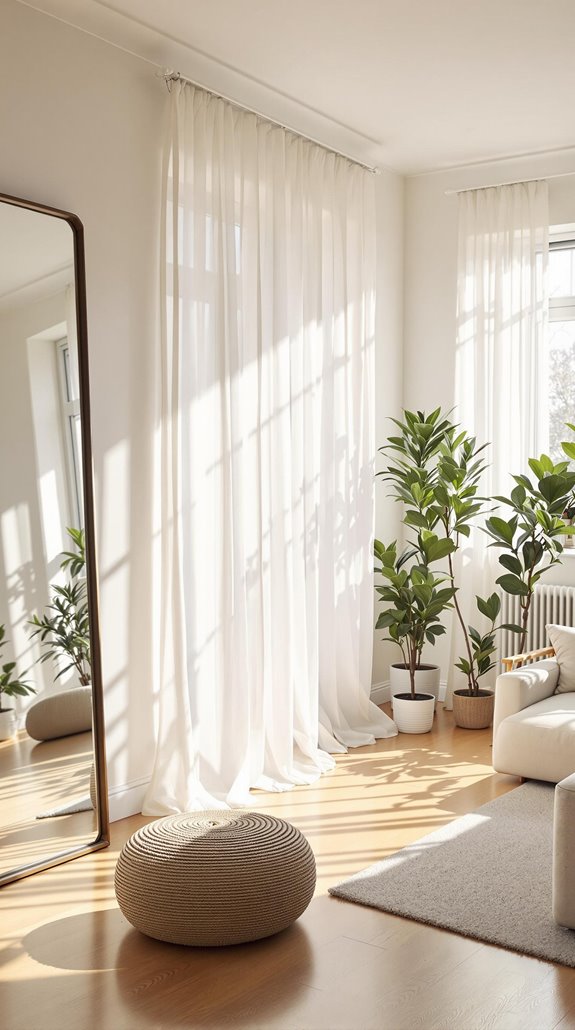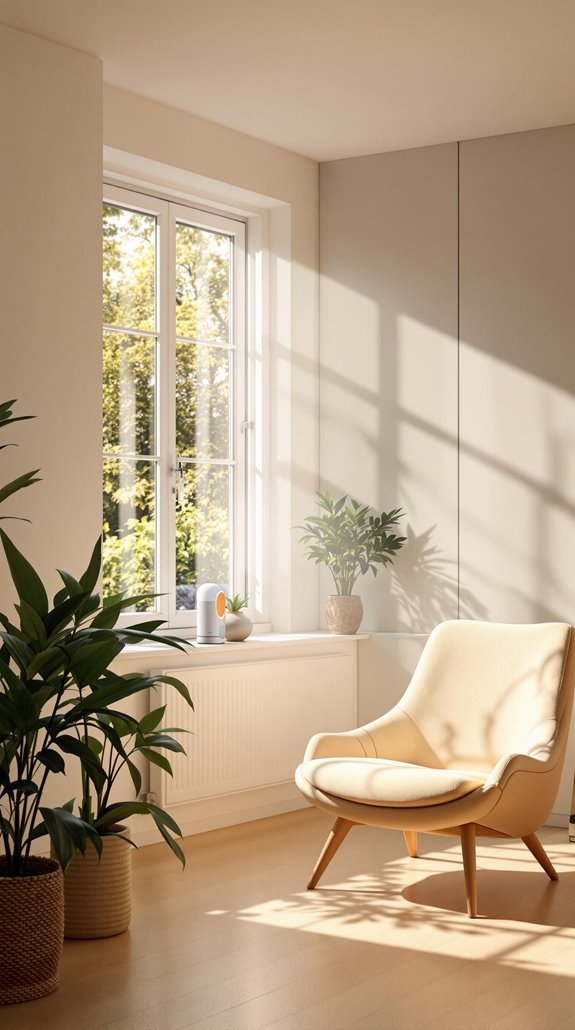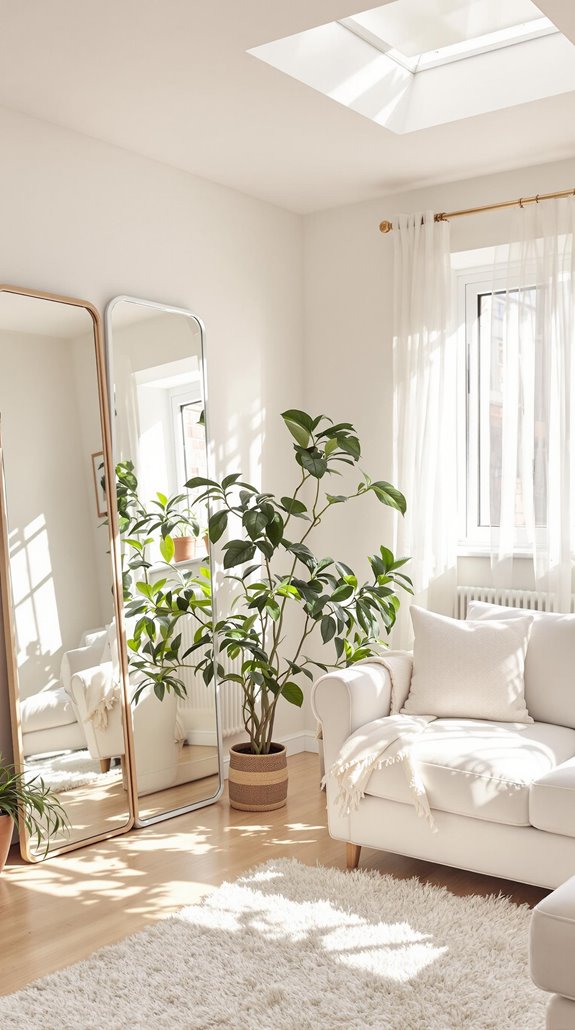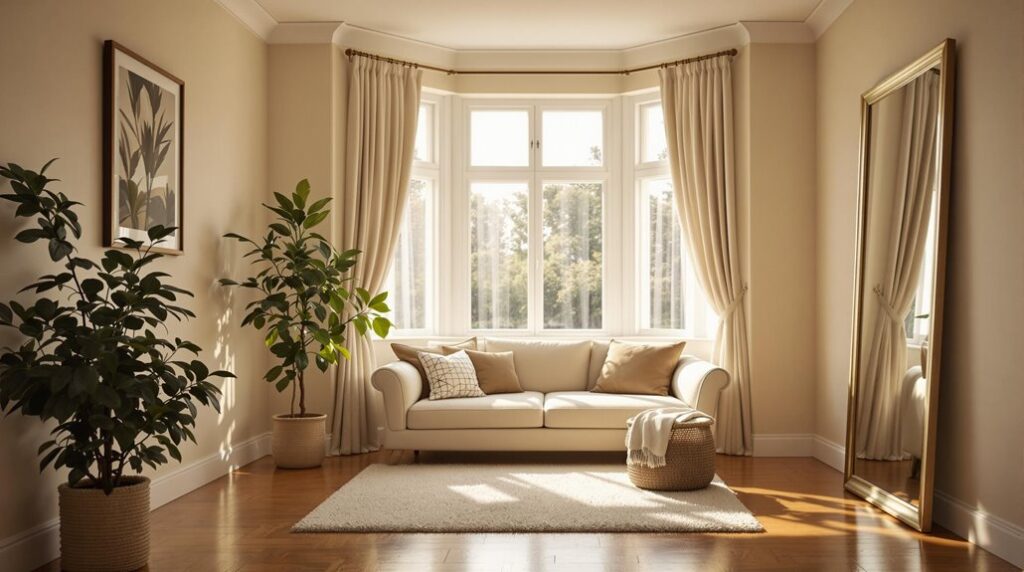I’ve tackled countless dark UK homes where Victorian terraces and post-war builds trap residents in perpetual gloom. The culprits are predictable: narrow windows, deep room layouts, and Britain’s notoriously overcast skies. However, I’ve discovered that strategic interventions—from precision-placed roof windows to calculated interior modifications—can transform even the darkest spaces. The key lies in understanding light physics and architectural constraints before selecting your approach. Let me show you the exact methods that’ll maximize every available photon in your home.
Key Takeaways
- Install skylights, roof windows, or sun tunnels in single-story extensions and upper floors to dramatically increase natural light penetration.
- Remove interior walls and use glass partitions to create open-plan spaces that allow light to flow between rooms.
- Place oversized mirrors strategically opposite windows to double incoming natural light and enhance room brightness.
- Paint walls and ceilings in light colors with high Light Reflectance Values (>70%) to maximize light bouncing throughout spaces.
- Replace heavy curtains with sheer fabrics or light-filtering blinds while keeping windows clean and trimming exterior foliage regularly.
Understanding Why UK Homes Suffer From Poor Natural Light
When examining why UK homes consistently struggle with insufficient natural light, you’ll find the problem stems from both historical taxation policies and modern building practices that prioritize cost savings over illumination.
The notorious Window Tax (1696-1851) created lasting architectural damage. Homeowners bricked up windows to avoid wealth-based taxation, permanently reducing natural light and ventilation. This legacy persists in countless period properties today.
Modern construction compounds these issues through restrictive building regulations requiring low U-values for energy efficiency, safety standards mandating upper-floor windows at least 1.1 meters above floor level, and developer cost-cutting measures. Larger windows mean higher expenses, so builders consistently choose smaller openings. Additionally, British homeowners’ preference for privacy in homes influences design choices, often limiting the adoption of more expansive window solutions that could dramatically improve natural light.
Understanding these root causes helps us tackle your home’s lighting challenges with targeted solutions that work within existing constraints.
Architectural Extensions and Glazing Solutions for Maximum Light
While traditional window replacements offer limited impact in UK homes, architectural extensions and strategic glazing installations can dramatically transform your property’s natural light levels. I’ll guide you through proven solutions that fellow homeowners have successfully implemented.
For single-story extensions, install skylights or roof windows positioned along narrow spaces to eliminate dark zones. You’ll maximize light penetration by choosing pitched roof designs over flat alternatives. When traditional windows aren’t feasible, sun tunnels provide effective overhead illumination. Additionally, transforming a conservatory into a bright living area can enhance light flow throughout your home.
Advanced glazing technologies deliver superior results. Specify Low-E glass to balance sunlight intake with thermal performance, while solar control glass prevents south-facing overheating. High-performance, minimally framed glazing maximizes daylight transmission. Consider triple glazing units which can significantly reduce heating costs while maintaining optimal light transmission.
Glass extensions offer extensive solutions. Design fully glazed conservatories for primary sunlight access, combining with internal glazing partitions to distribute light throughout your home effectively.
Retrofitting and Restoring Windows in Period Properties
Since period properties comprise over 20% of UK housing stock, restoring original windows demands specialized techniques that preserve historical integrity while achieving modern performance standards. I’ll focus on proven methods that fellow restoration enthusiasts use to maximize light while respecting heritage constraints.
Start with thorough condition assessments, documenting mortise-and-tenon joints and original glazing details. You’ll need specialist tools for timber repairs—epoxy resin injectors for joint reinforcement and micro-porous paints that let timber breathe. Install slimline double glazing within existing sashes to maintain sightlines while boosting thermal performance, which aligns with design aesthetics that enhance the overall character of the property.
For draught-proofing, use compression strips that won’t alter aesthetics. Rebuild sash weights and pulley systems using traditional methods. Victorian windows typically feature box sash designs with vertically sliding mechanisms that require careful restoration to maintain their original functionality. Budget £1,200–£2,500 per window for specialist craftsmen, but remember—we’re preserving architectural heritage while dramatically improving natural light transmission.
Installing Roof Windows and Light Tunnels for Upper Floors
Upper floor rooms often suffer from inadequate natural light, but roof windows and light tunnels offer transformative solutions that bypass traditional wall-mounted constraints. Permitted development rights can allow homeowners to enhance their living spaces without the need for planning permission, making these installations even more appealing.
I’ll focus on light tunnels since they’re particularly effective for spaces like corridors, stairwells, and bathrooms where conventional windows aren’t feasible. You’ll need to select appropriate sizing: 250mm diameter suits rooms up to 10m², while 350-450mm handles 10-15m² spaces, and 550mm works for 15-22m² areas.
Installation involves marking ceiling and roof positions, cutting precise holes, then securing the ceiling ring, dome, and flashing. Always check manufacturer instructions and verify proper insulation around the assembly. The flexible tube system navigates obstructions easily, while correct angling maximizes light reflection. All tunnel seams should be taped to ensure connections remain secure during installation. These energy-efficient solutions work under both pitched and flat roofs.
Interior Design Strategies to Amplify Existing Daylight

Once you’ve maximized your home’s natural light sources through windows and roof installations, strategic interior design choices can dramatically amplify the daylight you’re already receiving. I’ll start with reflective surfaces—install mirrors opposite windows to double incoming light and position them perpendicular to light sources for lateral scattering. Paint walls with high Light Reflectance Value (LRV) colors using satin or semi-gloss finishes that bounce light effectively. Additionally, consider the benefits of natural light sources as they can significantly enhance the overall ambiance of your home.
Choose light-colored furnishings and avoid dark upholstery in low-light zones. Install sheer curtains or adjustable blinds instead of heavy drapes, mounting rods higher and wider than windows to expose full glass surfaces. Consider textured wall finishes that soften lighting effects while maintaining brightness, as these create visual interest without compromising light distribution. For privacy without sacrificing brightness, use frosted glass partitions and translucent interior doors. These targeted strategies transform existing daylight into all-encompassing illumination.
Open-Plan Layouts for Better Light Distribution
While traditional room divisions serve functional purposes, they create significant barriers to natural light distribution throughout your home. I’ll show you how open-plan layouts can transform your space’s luminosity.
Removing interior walls enables unobstructed light penetration, allowing single windows to illuminate multiple zones simultaneously. You’ll achieve 30% deeper daylight penetration through connected spatial volumes while maintaining functionality through strategic furniture grouping. Additionally, the incorporation of contemporary design elements can further enhance the overall brightness and appeal of your home.
I recommend using low-height partitions and glass-block dividers that preserve light flow while creating visual boundaries. Corner windows capture multi-directional daylight, while clerestory windows distribute illumination deep into interiors. Consider implementing layered lighting techniques to complement your natural light sources and ensure effective illumination throughout the connected spaces.
Your material choices matter: select high LRV surfaces (>70%) and glossy finishes that amplify light diffusion. Glass internal doors and transparent furnishings maintain visual permeability, creating cohesive, bright living spaces.
Commercial Light Therapy Products for Dark Spaces

Beyond architectural modifications, commercial light therapy devices offer targeted solutions for combating the physiological effects of limited natural light in UK homes. I’ve found that devices like the Mito Red Light Sleep Lamp deliver 633nm flicker-free red light that counteracts blue-light exposure while supporting melatonin production for better sleep quality. The SaunaSpace Glow provides up to 34 mW/cm² irradiance with zero EMF emissions, using incandescent FireLight® bulbs for full-spectrum infrared therapy without LEDs. For those dealing with seasonal migraines, MitoGREEN™ combines 520nm green light with red/near-infrared wavelengths for symptom management. These devices stimulate mitochondrial function, reduce inflammation, and improve skin texture by boosting collagen production—addressing the cellular-level impacts of light deprivation. Premium systems like the MitoPRO X Series feature touchscreen controls with brightness adjustment and six different wavelengths for comprehensive home therapy applications.
Automated Glazing Systems and Smart Window Solutions
How can modern glazing technology transform your dark UK home into a naturally lit sanctuary? I’ll show you how automated glazing systems revolutionize light management in dark spaces.
Self-tinting electrochromic glass adjusts opacity based on sunlight intensity, while integrated thermal sensors monitor heat transfer for real-time optimization. You’ll achieve U-values as low as 1.3 W/m²K with argon-filled triple glazing—essential for meeting the UK’s 2025 Future Homes Standard requirements. Additionally, enhanced indoor air quality can be achieved with the integration of MVHR systems alongside modern glazing solutions.
Centralized automation hubs enable remote operation via mobile apps, with 45% of UK homeowners already using voice control compatibility. Sun-tracking algorithms optimize tint schedules throughout daylight hours, reducing artificial lighting dependency by 60%. The convenience and efficiency of these interconnected solutions drive increasing demand for automated glazing systems across UK households.
Your semi-detached home saves £95 annually through A-rated systems, while the £15,000 initial investment offsets long-term energy costs effectively.
Cost-Effective DIY Methods to Brighten Your Home

Five proven DIY methods can transform your dark UK home without breaking the bank or requiring professional installation. I’ll start with strategic mirror placement—position mirrors opposite windows to double natural light and create artificial “windows” using oversized mirrors. You can lean floor mirrors against walls for adjustable reflection angles. Adding creative lighting options such as pendant lights or under-cabinet fixtures can further enhance the brightness in your home.
Next, I recommend revitalizing your paint scheme. Apply matte-finish paint in light colors to avoid glare while maximizing brightness. Paint ceilings white to amplify overhead light distribution by up to 90%. Light-coloured walls help bounce light and create a brighter ambience throughout your living spaces.
For window optimization, trim exterior foliage blocking light ingress and clean windows quarterly. Replace heavy curtains with light-filtering blinds or sheers. Finally, choose reflective furniture like metal side tables and leather upholstery over fabric to boost light reflection throughout your space.
Conclusion
I’ve covered extensive solutions from architectural modifications to cost-effective DIY approaches for maximizing natural light in your UK home. You’ll achieve ideal results by combining multiple strategies: installing roof windows or light tunnels, using high-LRV paints, positioning mirrors strategically, and maintaining clean glazing. Don’t overlook automated systems for year-round light management. Start with budget-friendly methods like window cleaning and foliage trimming, then progress to structural solutions based on your home’s specific light deficiencies and requirements.
References
- https://www.thelondoneconomic.com/property/why-do-british-homes-skimp-on-natural-light-391480/
- https://pmc.ncbi.nlm.nih.gov/articles/PMC3072912/
- https://www.eurocell.co.uk/blog/the-hidden-cost-of-poor-natural-light-how-uk-businesses-are-losing-billions
- https://www.iqglassuk.com/news/how-to-improve-natural-light-in-narrow-properties/bp61/
- https://cms-group.co/considering-natural-light-in-interior-design/
- https://researchbriefings.files.parliament.uk/documents/CBP-9889/CBP-9889.pdf
- https://researchbriefings.files.parliament.uk/documents/CBP-9696/CBP-9696.pdf
- https://pmc.ncbi.nlm.nih.gov/articles/PMC7828303/
- https://assets.publishing.service.gov.uk/media/65705f3a739135000db03bc3/HECC-report-2023-chapter-13-solar-radiation.pdf
- https://abc-home.co.uk/maximizing-natural-light-in-dark-extensions-with-skylights/

